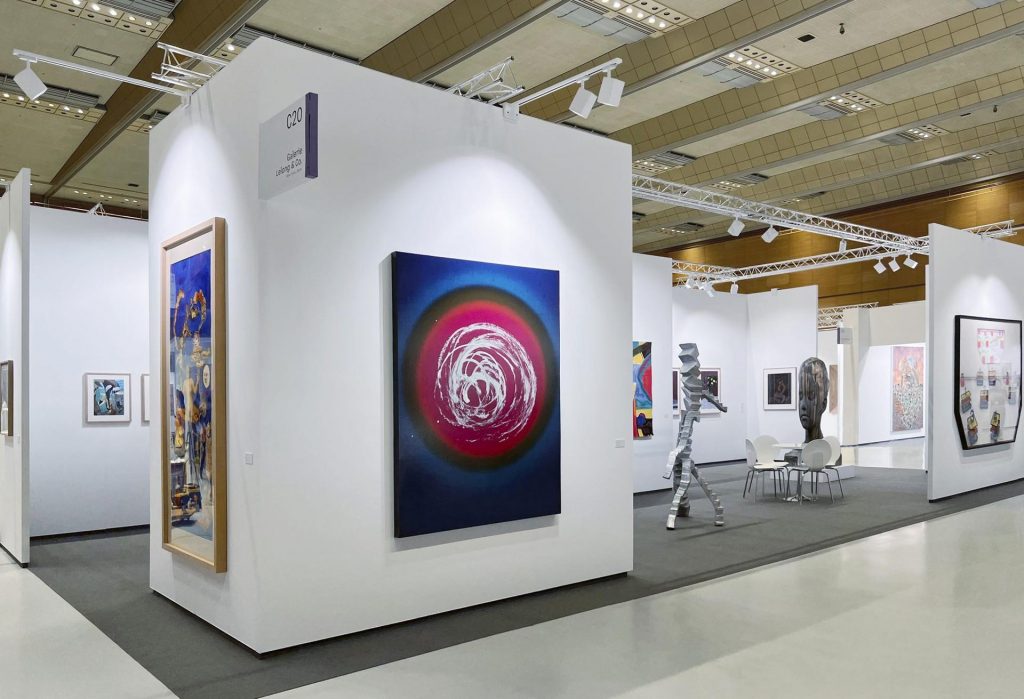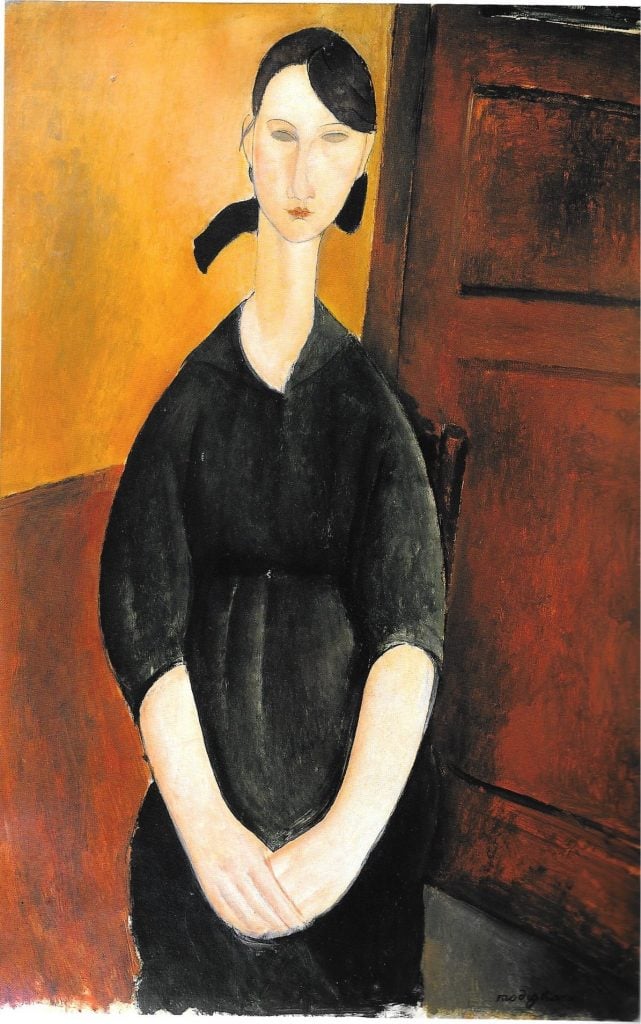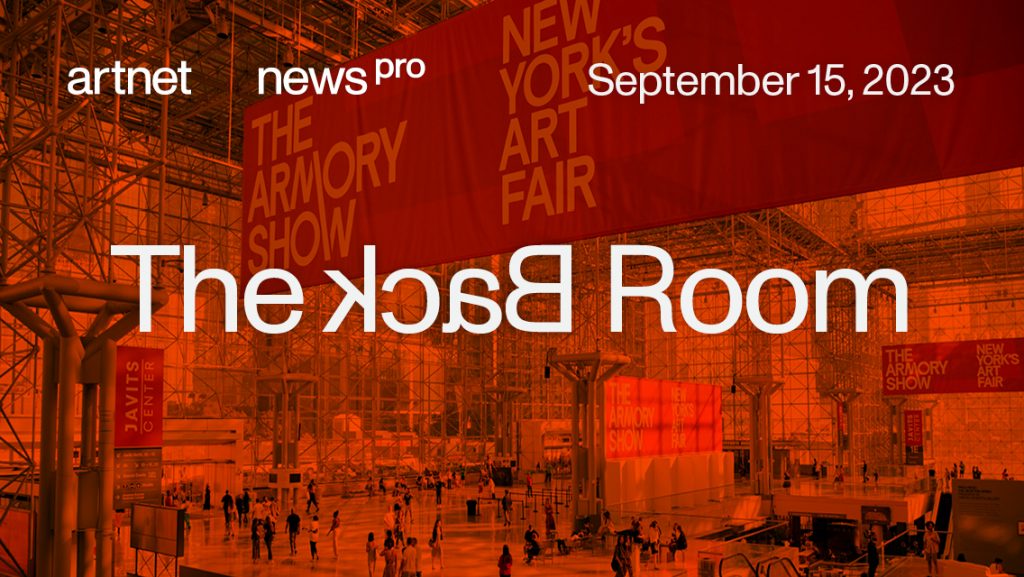Every Friday, Artnet News Pro members get exclusive access to the Back Room, our lively recap funneling only the week’s must-know intel into a nimble read you’ll actually enjoy.
This week in the Back Room: a look at the art-fair landscape post-Armory, the Long Museum’s marvelous Modigliani, and much more—all in a 7-minute read (2,100 words).
Top of the Market
Grow or Go

Galerie Lelong’s booth at Frieze Seoul 2023. Courtesy: Galerie Lelong.
The first Armory Show under the ownership of art-fair power player Frieze concluded Sunday at New York’s Javits Center, and top of mind for The Back Room this week was what Frieze’s latest acquisition—its second New York fair, which also overlaps with the second edition of Frieze Seoul—tells us about the increasingly congested art fair calendar. Can galleries, collectors, and advisors, possibly do it all without burning out, both personally and financially? Moreover, can the big art fair brands like Art Basel and Frieze continue to expand at the rate they are going without, as Katya Kazakina put it in last week’s The Art Detective, “diluting and cannibalizing themselves?”
Both these questions have played out in the art market before. Let’s cast our minds backwards for a moment.
- The crowded art fair landscape was already causing problems before the pandemic, with some galleries taking part in more than a dozen events a year, the hamster wheel spinning so relentlessly that the word fairtigue entered the art world lexicon as far back as 2018. When the pandemic rolled in, many swore they would not return to the way things were.
- Consolidation among the biggest players is also not a new thing. MCH Group, Art Basel’s Swiss parent company, essentially gorged itself on regional fairs between 2016 and 2018, acquiring majority stakes in the India Art Fair and Masterpiece London, while taking a minority stake in Art Düsseldorf and announcing plans to launch the Art SG fair in Singapore. However, by November 2018, MCH Group had effectively exited Art SG, the India Art Fair and Art Düsseldorf; everyone recalls what happened to Masterpiece (although Brexit surely deserves its share of the blame there).
All this happened in a low interest rate environment without the overarching geopolitical headwinds that are lurking this season, when some predict a long-feared market bloodbath will finally materialize. Still, it looks as though things might actually be getting worse. Consider this:
- Frieze Seoul is symbolic of the art world expanding beyond its traditional hubs. Hong Kong, which used to be the center of the art trade in Asia, is no longer the attractive destination it once was, and as rival hubs vie for the spot, we can expect even more events testing the water in different parts of the APAC region.
- Consolidation is back in a big way. MCH Group subsumed rival French fair FIAC, birthing Paris Plus in October, and one knock on effect on its flagship European fair in Basel was felt this June, in a notable absence of American collectors, who famously love gay Paree. And as we know, Endeavor, which has owned Frieze since 2016, recently went on a shopping spree, adding EXPO Chicago as well as the Armory, to its portfolio.
And while the expansion and the buys have helped Frieze position itself as the only real rival to Art Basel, silly little things like logistics and art fair burn out still threaten to undermine both behemoths as they battle for supremacy, especially as dealers consider how best to allocate limited resources in an uncertain market environment. Here are the early signs we spotted last week of the challenges ahead:
- The fact that much of the chatter at Armory was about Frieze Seoul underscores the fundamental issue Frieze now faces: it owns two fairs that take place in the same week. Officials maintain that unfortunate overlap will not change in the immediate future.
- Frieze’s first New York fair, Frieze New York, is still at the Shed, which dealers still hate for its cramped booths, stirring rumors that Frieze’s play for the Armory was real estate-motivated. Word has it that the contractual relationship with the Javits Center was part of the brand’s interest in Armory, though officials maintain that any talk of merging the two fairs is still out of the question.
- Many gallerists were stretched thin by appearing on two continents simultaneously—namely Galerie Lelong, Almine Rech, and Ben Brown. Notable: exhibitor count at Armory was also down by 15 galleries this year. Galleries that used to show at the Armory but are now doing only Frieze Seoul include David Zwirner, Massimo De Carlo, and Sadie Coles. Not exactly a roster of minor players.
The Bottom Line
All that goes to say that the wages of consolidation are… well, not death, surely, but they may be more significant than the global art brands believe.
One question raised by all of this, however, is that, given the size of the behemoth companies now behind these brands, does the existential threat to small fry acquisitions like a silly little art fair here or there even matter?
Artnet News’s Katya Kazakina revealed this week the price tag for the Armory—a cool $24.4 million—and the $16.5 million Frieze’s parent company Endeavor Group Holdings spent recently to buy out the 30 percent stake in Frieze previously still held by its founders. The Art Detective dug the numbers out of public filings from both Armory seller Vornado Realty Trust and Endeavor.
It’s hard to peg what those numbers indicate, as art fair pricing isn’t exactly transparent and transactions of the scale of Frieze’s 2023 shopping spree are rare, so there are no comparables. But as Katya points out, the purchase is tiny in the grand scheme of Endeavor’s M&A activity given that it plunked down $9.3 billion to acquire WWE, the professional-wrestling company, in April.
As what The Back Room once dubbed “the art fair consolidation derby” continues on, it seems the megaliths in the industry have grown to the size where they’re unable to avoid cannibalizing themselves. It’s a long game, sure, but… how long?
Read More
Paint Drippings
The latest Wet Paint was still being mixed at press time. But here’s what else made a mark around the industry since last Friday morning…
Art Fairs
- Art Basel Miami Beach released the exhibitor list for the December 2023 edition, with 277 galleries participating (less than last year’s 283). New director Bridget Finn is helming the fair, which will feature a new layout to aid visitor flow. The concurrent Untitled Art fair will host its largest edition yet, with 163 exhibitors. (Artnet News; ARTnews)
- The luxury fashion brand Stone Island is embarking on a multi-year partnership with Frieze to offer funding of up to 30% of stand fees for emerging galleries in the Focus section. (The Art Newspaper)
- ICYMI, here’s what a selection of art dealers say they sold at the sophomore edition of Frieze Seoul last week. (Artnet News)
Auction Houses
- Hindman auction house (the result of a 2019 merger between Chicago’s Leslie Hindman Auctioneers and Ohio’s Cowan’s Auctions) is launching its debut season in New York City. Single-owner sales of watches, photographs, paintings, and ceramics will hit the block from October 18–26. (Press release)
- Sotheby’s has won the coveted estate of the late art collector and patron Emily Fisher Landau this November. The star lot is Picasso’s 1932 painting Femme à la montre (Woman With a Watch) estimated to sell for around $120 million. (Artnet News)
Galleries
- At long last, we now know some of Marc Spiegler’s plans for life after Basel, and it’s… Superblue? Spiegler has joined the board of directors of the experiential art center one year after high-profile backers Laurene Powell Jobs and Pace’s Marc Glimcher stepped away from the company.(ARTnews)
- A court has found mega-gallery Gagosian not liable for unrealized profits related to work by Richard Prince, whose Instagram-based appropriation art is the center of an ongoing copyright lawsuit brought by photographer Donald Graham. (Artnet News)
- Veteran London gallery Modern Art is expanding to open an outpost in Paris just in time for Paris+, though it is not participating in the fair this year. Founder Stuart Shave says that the new location will operate differently, with only three exhibitions each year, open by appointment only. (The Art Newspaper)
- The Breeder gallery now represents Greek artist Miltos Manetas, and will present new and historic works at Frieze London this October. British artist Dexter Dalwood has joined the stable at Lisson Gallery, who will show his paintings at Paris+ and Art Basel Miami Beach this year. Almine Rech announced global representation of French artist Sasha Ferré, whose work the gallery will feature at Paris+ and ABMB. And finally, Chinese artist Lyn Liu has officially joined Kasmin after a successful exhibition of her work at the Armory Show. (Press releases)
Institutions
- Beginning on October 16, visitors to MoMA will have to shell out $30 for admission, continuing a trend across the country where museums have increased ticket prices by up to 20 percent. The museum cited financial stability as a factor for the move. (New York Times)
- Last week Sydney Contemporary reported $21 million in art sales and over 25,000 visitors to the fair, making it the largest in the event’s history. (Press release)
- Brooklyn cultural center Pioneer Works has named Mara Manus, currently the executive director of the New York State Council on the Arts, as its CEO. She succeeds Maxine Dalio, who left the job last year. (Press release)
- For-profit museum Fotografiska has opened its third location in Berlin in a former artist squat and grassroots arts space. Programming kicks off with solo exhibitions of work by Juliana Huxtable and Candice Breitz. (Artnet News)
Tech and Legal News
- Art dealer Robert Newland, who pleaded guilty last year to his role in a massive fraud scheme with imprisoned dealer Inigo Philbrick, has just filed bombshell new documents in a U.S. District Court ahead of his sentencing in New York next week. In the bid for leniency, Newland reveals in stunning detail in how the pair churned through tens of millions of dollars in fraudulent art sales—and paints Philbrick as the operation’s mastermind. (Artnet News)
- In a new win for the Cambodian government in its ongoing mission to reclaim its looted cultural heritage, the family of billionaire collector George Lindemann has agreed to voluntarily return 33 stolen antiquities. (Artnet News)
- The estate of John Baldessari, who died in 2020, is suing the conceptual artist’s former gallery and an insurance company over allegedly damaged works and a cancelled show with Gagosian Gallery. (ARTnews)
“Although there were opportunities in other places, there was something about joining Superblue … they were working in a space that I’ve often thought was rife with possibility.”
—Former Art Basel global director Marc Spiegler on his decision to join the board of experiential art center Superblue. (ARTnews)
Work of the Week
Amedeo Modigliani’s Paulette Jourdain

Amedeo Modigliani, Paulette Jourdain (1919).
Date: 1919
Seller: Liu Yiqian and Wang Wei
Estimate: More than $45 million
Selling at: Sotheby’s Hong Kong autumn sales
Sale date: October 5, 2023
The founders of the Long Museum in China, one of the most active and prestigious new institutions in the country, are selling 40 lots at Sotheby’s in Hong Kong this fall.
The auction comes amidst a slowdown in the art market and China’s economic struggles, which include the collapse of country’s property market.
The Modigliani represents about a half to a third of the consignment’s total presale estimate of $95.9 million to $135.5 million. Other highlights including paintings by Zao Wou-ki, René Magritte, David Hockney, Yayoi Kusama, and Matthew Wong.
The collectors acquired Paulette Jourdain at the famous auction of the A. Alfred Taubman collection at Sotheby’s in New York on Nov. 4, 2015. The couple was known to sometimes overpay for works they had coveted and Paulette Jourdain is no exception. Estimated at $25 million at the time, it fetched $42.8 million, landing as the top lot of Taubman sale.
The somber canvas depicts a 19-year-old model wearing black and is one of the artist’s largest paintings.
But it’s not the most prized Modigliani in Liu and Wang’s collection. That honor belongs to Nu couché (1917-1918), a ravishing nude they bought just five days after acquiring Paulette Jourdain, at Christie’s. The $170.4 million price remains the auction record for Modigliani and the crown jewel of the Long Museum. It is not offered in the upcoming sale.
—Katya Kazakina
Thanks for joining us in the Back Room. See you next Friday.




